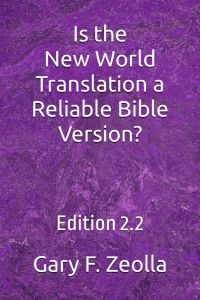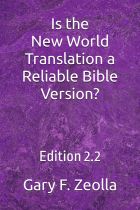
Additional Books and eBooks by the Director
Is the New World Translation a Reliable Bible Version?
Edition 2.2
Updated November 2023
By Gary F. Zeolla, the Director of Darkness to Light
Available from Amazon for as little as $1.75
“Is the New World Translation a Reliable Bible Version? A Verse-by-Verse Examination”
Edition 2.2 – Updated & Expanded (2023)
The Definitive Critique of the Jehovah’s Witnesses’ Bible
This concise but powerful analysis exposes how the New World Translation:
✔ Misrepresents key Greek terms to fit Watchtower theology
✔ Adds and omits words without justification
✔ Fails its own claims of being a “literal” translation
Why This Book?
Most critiques of the NWT focus on John 1:1 and Christ’s deity. This study is different. It examines:
- Paul’s Epistle to the Ephesians – A less-discussed but critical text
- Side-by-side comparisons with the Kingdom Interlinear (the Watchtower’s own Greek interlinear)
- Word-for-word accuracy tested against the NKJV and Analytical-Literal Translation (ALT3)
Key Findings:
- Undisclosed Additions & Omissions
- Words added to support JW doctrine
- Key Greek terms left untranslated when inconvenient
- Grammatical Manipulation
- Verb tenses altered to weaken Christ’s authority
- Prepositions mistranslated to fit Arianism
- Inconsistent “Literal” Claims
- The NWT claims to be word-for-word—but often isn’t
- Compare: The Kingdom Interlinear (literal) vs. the NWT (doctrinally biased)
- Readability ≠ Reliability
- The NWT is clear—but clarity at the cost of accuracy
How This Study Works:
Each examined verse includes:
- NWT Reading – The Jehovah’s Witnesses’ translation
- Kingdom Interlinear (KIT) – The Watchtower’s own literal rendering
- NKJV & ALT3 – Faithful translations for comparison
- Greek Analysis – Lexical & grammatical breakdown
- Conclusion – Is the NWT trustworthy here?
Who Should Read This?
- Christians witnessing to JWs – Equip yourself with hard evidence
- Bible students – Learn how to spot translation bias
- Pastors & teachers – Defend the integrity of Scripture
“Even the Watchtower’s own interlinear contradicts their ‘translation.’”
Edition 2.2 Updates:
✔ New Cover & Title Clarification
✔ Minor Corrections Throughout
✔ Updated Appendixes
Available in:
- Paperback (Compact, easy to share)
- PDF eBook (Searchable & hyperlinked)
Why This Matters:
The NWT isn’t just “another translation”—it’s a theological weapon used to:
- Deny Christ’s deity
- Promote Watchtower authority
- Deceive seekers
This book exposes the deception—with facts, not rhetoric.
“But be examining all [things]; be holding fast [to] the good” (1Thessalonians 5:21; ALT3).
Complete Your Collection:
Pair this with the author’s Differences Between Bible Versions for a full defense of translation integrity.
The NWT is the Bible of Jehovah's Witnesses. This review evaluates the NWT by looking at select passages from Paul’s Epistle to the Ephesians. The standards I use are the same standards that I use in my book Differences Between Bible Versions. Simply put, does the translation faithfully and accurately render the Greek text into English?
Available Formats
Amazon:
Kindle Reading Device eBook: $1.75. Order and download from Amazon.
Paperback format: 74 pages. $5.99. Order from Amazon.
Lulu:
Acrobat Reader® eBook format: 73 pages. 796 KB. $1.75. Purchase and download from Lulu Publishing.
ePub (for iPad, Nook, etc.) eBook: 63 KB. $1.75. Order and download from Lulu Publishing.
Paperback format: 74 pages. $4.68. Order from Lulu Publishing.
Notes:
Different formats and publishers might have different covers, but the content is the same in all of them.
Readers
Download the free PDF Reader (Acrobat Reader®)
Purchase the Kindle Wireless Reading Device
Description
 The New World Translation of the Holy Scriptures (NWT) is published by the Watchtower Bible
and Tract Society (WT). This is the organization that Jehovah’s Witnesses
belong to. But how reliable is this Bible version?
The New World Translation of the Holy Scriptures (NWT) is published by the Watchtower Bible
and Tract Society (WT). This is the organization that Jehovah’s Witnesses
belong to. But how reliable is this Bible version?
Much has been written about the NWT in regards to passages dealing with the deity of Christ. So rather than going over that much worn ground, this review will instead evaluate the NWT by looking at select passages from Paul’s Epistle to the Ephesians.
The verses will be quoted first from the NWT, then from the word-for-word translation in the Watchtower’s own Kingdom Interlinear Translation of the Greek Scriptures (KIT). Since the NWT claims to be a literal version (see below), it will be seen how close it follows its own interlinear reading. And then the passage will be quoted from the New King James Version (NKJV) and from this reviewer’s own Analytical-Literal Translation: Third Edition (ALT3).
The standards I will use here are the same standards that I use in evaluating over thirty versions of the Bible in my book Differences Between Bible Versions. Simply put, does the translation faithfully and accurately render the Greek text into English?
More specifically, are words translated correctly? Are words left untranslated? Are words added without any indication that they have been added? Are the grammatical forms of words altered? Are phrases paraphrased rather than translated? How readable is the text? And how reliable is the Greek text being translated?
This edition 2.2 of this booklet published in 2023 is a corrected text not a full new edition. The title has been slightly changed for clarification purposes, minor corrections have been made throughout, plus the cover and appendixes have been updated

Click for more information and to order.
Disclosure: As an Amazon Associate, I earn commissions from qualifying purchases.
The above preview was first posted on this website July 14, 2001.
It was last updated June 19, 2025.
![]() Additional
Books and eBooks by the Director
Additional
Books and eBooks by the Director
![]() Alphabetical
List of Pages
Alphabetical
List of Pages ![]() Subject
Index
Subject
Index
![]() Contact Information
Contact Information
Darkness
to Light Home Page
www.zeolla.org/christian